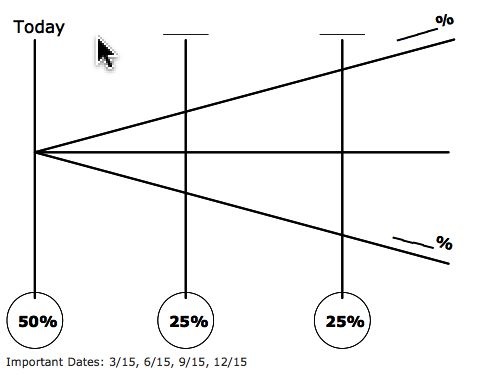FOUR NEXT ACTIONS BEFORE DECEMBER 15TH
The window of time left is small, but the opportunity is great. In the next four weeks you can make a significant difference in the lives of others. And as they see in your actions your desire to help them achieve their dreams you can replace the lost assets that the market has temporarily taken away. So instead of just breaking even when the market returns, you can have a significant gain in assets and revenue, while having added outstanding value to the relationship.[display_podcast] Two Mental Paradigm 1. You must have a passion to make a positive difference in the life of other people.
2. Partner up with your clients to calm the fears and concerns of those they value and respect.
Window of Opportunity from now to December 15th 1. Clients are scared. They feel that their dreams are at risk. This is a rare opportunity to touch the lives of others in a meaningful way and help them achieve their dreams.
2. December is family month. They will not want to talk with you after December 15th. Everyone will be busy with the holidays.
3. January Effect A. New popular President B. New Administration C. New Year D. Bad October
4. The opportunity is now.
Stop Putting Band-Aids on Scratches While Other Are Bleeding To Death If you have: 1. Taken your clients through a relationship conversation 2. Identified their Risk Profile 3. Properly allocated their assets 4. Diversified their portfolio 5. Communicated with them throughout this market decline 6. Offered them the opportunity to re-profile their risk 7. Answered their questions THEN YOU HAVE DONE EVERY THING YOU CAN.
Where Is Your Focus? When things are good focus on your clients, because during these times clients are difficult to replace. Everyone is happy with their current relationships. Therefore strengthen your client relationships by helping them fulfill their dreams. This will be easier during the good times.
During Difficult Times First prepare yourself, then settle your clients worries quickly. 1. Remind them that times like these have occurred in the past and will occur in the future. 2. Help them establish a long view of the economy. They have no need to worry. 3. Use the example of trusted experts: Bernanke / Buffett 4. Re-explain to then what controls the market 5. Re-confirm the disciplined process that you have taken them through to determine their needs and the unique solution that they have working for them currently.
Do not try to call or contact each client personally, use mass communication tools like email, broadcast fax, letter, podcast, or conference call. The exception to this would be your Top 25 Clients who you should call after you have sent the mass communication information.
FOUR NEXT ACTIONS 1. Capture All Tax Credits The tax credit is cash captured now guaranteed.
2. Letter to Clients Send a letter to all your clients reminding them of the steps that have been taken to protect them. Offer them the opportunity to reassess their risk profile Most Important: Include a paragraph
3. Contact All Old Prospects Make sure they are not worried. Offer analysis, at no cost, and no obligation. If they say no in this situation, they are either well serviced or not interested in working with you. Either way remove them from your prospect list. They are not prospects.
4. Call Top 25 Partner up with them to make a positive difference in the live of someone they value and respect.
Example script for call Mr. Client over the past several weeks we have talked to many people who are worried and fearful. They had no one to help them understand their situation. If you know someone you respect and value who is worried, there is no need from them to be in that situation. We’ll be happy to take them through the same analysis we use with each of our clients, at no cost or obligation, to make sure that they know where they are today, where they want to be in the future, and have a plan of action to get there. We do not what someone you care about to be afraid.
Introduce us to each other. Send them an email and copy us. Simply same Bill, I want to introduce you to Sally. Sally I want to introduce you to Bill. Here is the contact information for each of you. You should talk together.
The conversation is just that easy.
Call Top 25 1st week, then the next 25 the next week, then back to the Top 25 the following week, and then back to the next 25 the last week.
For more information see: -Sample Letter to Clients -Mastery Habit: Crisis Management -Mastery Habit: In Good Times Focus on Your Clients, In Bad Times Focus on Prospects -Mastery Habit: Never Follow Institutional Managers During the Extremes in the Market -Notes from the last conference call -Link to Fed Chairman Bernanke’s Speech to the Economic Club of NY -Link to Warren Buffett’s letter to the NYT To conduct a conference call with your clients contact: Ed Shea from Audio Podium Email: coachimago@aol.com
If you have found this of value, forward this page to someone you respect and value who is worried.
